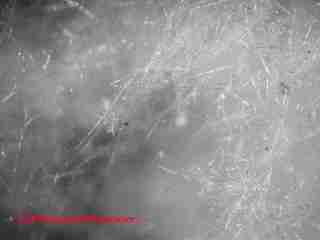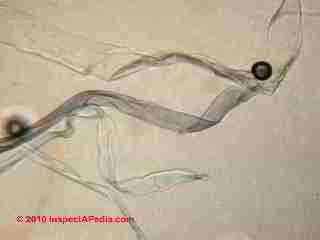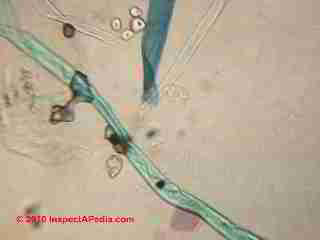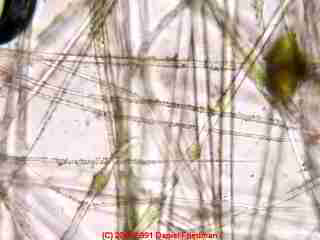 Building or House Dust Particle Identification
Building or House Dust Particle Identification
Screen for Fiberglass Particles
Test Laboratory Procedures
- POST a QUESTION or COMMENT about fiberglass dust particle identification procedures & testing
House dust test procedure or other building dust sampling for fiberglass:
This indoor air quality testing article describes the process for laboratory identification of particles found in indoor air or settled dust collected in residential and light-commercial buildings.
Typical components of house dust are dominated by fabric fibers and skin cells. We may however find either high levels of common problem particles (mold, allergens, fiberglass or other insulation fragments) or low levels of particles that by their nature still indicate a problem.
Here we include photographs of unbonded fiberglass insulation - blowing wools. How to distinguish between fiberglass fibers & fabric fibers in house dust. Microscope procedures for identification of fiberglass. Fiberglass lab test warnings & tips.
Our page top photo shows a vacuum sample of fiberglass building insulation. The bonding resin is plainly visible in our lab photo - often the color of the binding resin in fiberglass insulation helps trace insulation dust in a building back to its source. Not all fiberglass insulation includes resin binders however.
InspectAPedia tolerates no conflicts of interest. We have no relationship with advertisers, products, or services discussed at this website.
- Daniel Friedman, Publisher/Editor/Author - See WHO ARE WE?
Simple Method for Identifying Contents of House Dust to Screen for Building Insulation (fiberglass fragments or other insulation materials)
This article describes easy steps taken in the forensic lab that permit reliable particle identification and distinguishing among fiberglass insulation, mineral wool or "rock wool" and cotton or other fibers.
Photographs of Unbonded Fiberglass Insulation - "Blowing Wools"
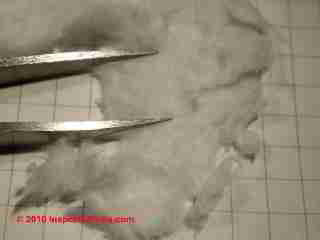
Above we show a macro photograph of white blown-in unbonded InsulSafe® building insulation sold by CertainTeed and provided by a homeowner who asked our lab to study dust samples from her home.
At above is the same insulation shown in the stereo microscope at about 20x, and below the same material is magnified to 720x.
How to Distinguish Between Fiberglass Fibers & Fabric Fibers in House Dust

Above we show a 720x micro-photograph of white blown-in unbonded InsulSafe® building insulation sold by CertainTeed.
Above our photo shows the dominant particles in the dust sample from the home under study.
Magnified to 720x the fibers we found were primarily cotton, with some linen and a few synthetic fabric fibers.
There was virtually none of the insulation fibers provided for comparison (above left) as a possible source of dust in the home.
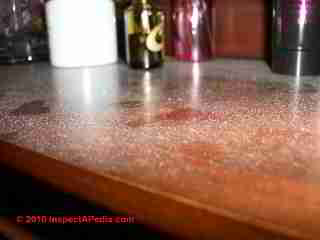
Above a client photo shows a heavy and rapid dust accumulation on building surfaces.
Above our lab photo shows that the prime contents of the dust were fabric fibers and starch granules, not building insulation in this case. - DF & WW 6/2010.
Fiberglass Lab Test Warnings & Tips
Watch out: when preparing a laboratory sample for microscopic examination for the present and level of fiberglass fragments (from insulation or any other source), choose the mountant liquid wisely.
If you use a slide mountant whose refractive index is close to that of glass fibers, detection of small fiberglass fragments may be difficult or impossible even though they may be present at high levels.
Thus while it may be trivial to distinguish fiberglass from other fibers found in building dust, it the mountant is not properly selected (with the proper n or refractive index), or if the microscope is not properly adjusted, the technician can completely miss high levels of ultra-fine fiberglass fragments.
Fiberglass Lab Tip - watch out for ultra-small fiberglass fragments
While detection of large fibers of any sort in a microscope sample is relatively easy, in our OPINION, some fiberglass dust studies have been faulty in design because technicians seriously under-report the presence of ultra-small fiberglass insulation fragments in dust samples.
This error occurs because of a combination of:
- Improper refractive index mountant
- Poor slide preparation
- Failure to adjust the microscope to high magnification to screen for particles near 1u in size
In sum, as forensic microscopists know well, if you don't look for a particle or a particle in the proper size range, preparation, and magnification, you will not find it.
Details about the problems of detecting ultra-small fiberglass fragments are
at FIBERGLASS DETECTION in BUILDING AIR & DUST
...
Continue reading at DUST SAMPLE TYPES or select a topic from the closely-related articles below, or see the complete ARTICLE INDEX.
Or see DUST ANALYSIS for FIBERGLASS FAQs - questions & answers posted originally on this page
Or see these
Fiberglass Hazard Articles
- DIRECTORY of MOLD / ENVIRONMENTAL EXPERTS
- DUST SAMPLING PROCEDURE
- DUST SAMPLE TYPES
- FIBERGLASS HVAC DUCTS
- FIBERGLASS HAZARDS - home
- AIR FILTERS, FIBERGLASS PARTICLES
- DUST ANALYSIS for FIBERGLASS
- FIBERGLASS ASBESTOS COMBINATIONS
- FIBERGLASS DETECTION in BUILDING AIR & DUST
- FIBERGLASS ENVIRO-SCARE
- FIBERGLASS FRAGMENT HAZARDS in AIR or DUST
- FIBERGLASS INSULATION EXPOSURE LIMITS
- FIBERGLASS PARTICLE CONTAMINATION TEST
- FIBERGLASS REINFORCED PLASTICS
- REFERENCES, FIBERGLASS HAZARDS
- FIBERGLASS INSULATION EXPOSURE LIMITS
- FIBERGLASS INSULATION IDENTIFICATION & PROPERTIES
- FIBERGLASS INSULATION MOLD
- HOUSE DUST ANALYSIS
- LAB IDENTIFICATION OF FIBERGLASS
- MORGELLONS SYNDROME
- TEST KIT for DUST, MOLD, PARTICLES: INSTRUCTIONS
Suggested citation for this web page
DUST ANALYSIS for FIBERGLASS at InspectApedia.com - online encyclopedia of building & environmental inspection, testing, diagnosis, repair, & problem prevention advice.
Or see this
INDEX to RELATED ARTICLES: ARTICLE INDEX to BUILDING FORENSICS
Or use the SEARCH BOX found below to Ask a Question or Search InspectApedia
Or see
INDEX to RELATED ARTICLES: ARTICLE INDEX to BUILDING ENVIRONMENT
Or use the SEARCH BOX found below to Ask a Question or Search InspectApedia
Or see
INDEX to RELATED ARTICLES: ARTICLE INDEX to BUILDING INDOOR AIR QUALITY IAQ
Or use the SEARCH BOX found below to Ask a Question or Search InspectApedia
Or see
INDEX to RELATED ARTICLES: ARTICLE INDEX to MOLD CONTAMINATION & REMEDIATION
Or use the SEARCH BOX found below to Ask a Question or Search InspectApedia
Ask a Question or Search InspectApedia
Try the search box just below, or if you prefer, post a question or comment in the Comments box below and we will respond promptly.
Search the InspectApedia website
Note: appearance of your Comment below may be delayed: if your comment contains an image, photograph, web link, or text that looks to the software as if it might be a web link, your posting will appear after it has been approved by a moderator. Apologies for the delay.
Only one image can be added per comment but you can post as many comments, and therefore images, as you like.
You will not receive a notification when a response to your question has been posted.
Please bookmark this page to make it easy for you to check back for our response.
IF above you see "Comment Form is loading comments..." then COMMENT BOX - countable.ca / bawkbox.com IS NOT WORKING.
In any case you are welcome to send an email directly to us at InspectApedia.com at editor@inspectApedia.com
We'll reply to you directly. Please help us help you by noting, in your email, the URL of the InspectApedia page where you wanted to comment.
Citations & References
In addition to any citations in the article above, a full list is available on request.
- Fiberglass carcinogenicity: Glass Wool Fibers Expert Panel Report, Part B - Recommendation for Listing Status for Glass Wool Fibers and Scientific Justification for the Recommendation", The Report on Carcinogens (RoC) expert panel for glass wool fibers exposures met at the Sheraton Chapel Hill Hotel, Chapel Hill, North Carolina on June 9-10, 2009, to peer review the draft background document on glass wool fibers exposures and make a recommendation for listing status in the 12th Edition of the RoC. The National Institute of Environmental Health Sciences is one of the National Institutes of Health within the U.S. Department of Health and Human Services. The National Toxicology Program is headquartered on the NIEHS campus in Research Triangle Park, NC.
- World Health Organization International Agency for Research on Cancer - IARC Monographs on the Evaluation of Carcinogenic Risks to Humans - VOL 81 Man-Made Vitreous Fibers, 2002, IARCPress, Lyon France, pi-ii-cover-isbn.qxd 06/12/02 14:15 Page i - World Health Organization, 1/21/1998. - Fiberglass insulation is an example of what IARC refers to as man made vitreous fiber - inorganic fibers made primarily from glass, rock, minerals, slag, and processed inorganic oxides. This article provides enormous detail about fiberglass and other vitreous fibers, and includes fiberglass exposure data.
- WHO- World Health Organization - IARC MONOGRAPHS ON THE IDENTIFICATION OF CARCINOGENIC HAZARDS TO HUMANS large PDF over 6MB)
https://publications.iarc.fr/ENG/Monographs/vol81/mono81-6A.pdf - article details
https://publications.iarc.fr/ENG/Monographs/vol81/mono81-6C.pdf - studies of cancer in experimental animals in re vitreous fibers such as fiberglass;
https://publications.iarc.fr/ENG/Monographs/vol81/mono81-6E.pdf - summary of data reported & evaluation
https://publications.iarc.fr/ENG/Monographs/vol81/mono81-6F.pdf for the article references
To search the IARC monographs on various environmental concerns and carcinogens, use https://publications.iarc.fr/ENG/Monographs/PDFs/index.php - Our recommended books about building & mechanical systems design, inspection, problem diagnosis, and repair, and about indoor environment and IAQ testing, diagnosis, and cleanup are at the InspectAPedia Bookstore. Also see our Book Reviews - InspectAPedia.
- ENVIRONMENTAL HEALTH & INVESTIGATION BIBLIOGRAPHY - our technical library on indoor air quality inspection, testing, laboratory procedures, forensic microscopy, etc.
- In addition to citations & references found in this article, see the research citations given at the end of the related articles found at our suggested
CONTINUE READING or RECOMMENDED ARTICLES.
- Carson, Dunlop & Associates Ltd., 120 Carlton Street Suite 407, Toronto ON M5A 4K2. Tel: (416) 964-9415 1-800-268-7070 Email: info@carsondunlop.com. Alan Carson is a past president of ASHI, the American Society of Home Inspectors.
Thanks to Alan Carson and Bob Dunlop, for permission for InspectAPedia to use text excerpts from The HOME REFERENCE BOOK - the Encyclopedia of Homes and to use illustrations from The ILLUSTRATED HOME .
Carson Dunlop Associates provides extensive home inspection education and report writing material. In gratitude we provide links to tsome Carson Dunlop Associates products and services.


